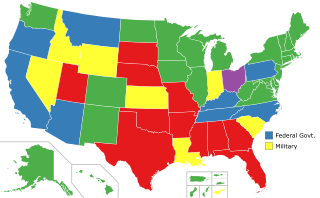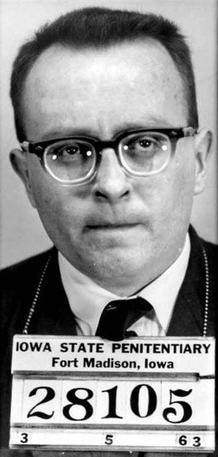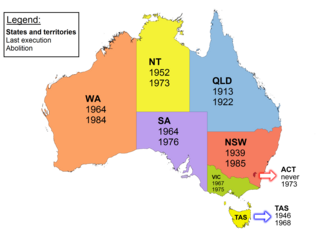Related Research Articles
Capital punishment, also known as the death penalty and formerly called judicial homicide, is the state-sanctioned practice of killing a person as a punishment for a crime, usually following an authorised, rule-governed process to conclude that the person is responsible for violating norms that warrant said punishment. The sentence ordering that an offender be punished in such a manner is known as a death sentence, and the act of carrying out the sentence is known as an execution. A prisoner who has been sentenced to death and awaits execution is condemned and is commonly referred to as being "on death row". Etymologically, the term capital refers to execution by beheading, but executions are carried out by many methods, including hanging, shooting, lethal injection, stoning, electrocution, and gassing.

In the United States, capital punishment is a legal penalty throughout the country at the federal level, in 27 states, and in American Samoa. It is also a legal penalty for some military offenses. Capital punishment has been abolished in 23 states and in the federal capital, Washington, D.C. It is usually applied for only the most serious crimes, such as aggravated murder. Although it is a legal penalty in 27 states, 20 states currently have the ability to execute death sentences, with the other seven, as well as the federal government, being subject to different types of moratoriums.

Capital punishment is a legal punishment under the criminal justice system of the United States federal government. It is the most serious punishment that could be imposed under federal law. The serious crimes that warrant this punishment include treason, espionage, murder, large-scale drug trafficking, or attempted murder of a witness, juror, or court officer in certain cases.

Capital punishment is a legal penalty in the U.S. state of Ohio, although all executions have been suspended indefinitely by Governor Mike DeWine until a replacement for lethal injection is chosen by the Ohio General Assembly. The last execution in the state was in July 2018, when Robert J. Van Hook was executed via lethal injection for murder.

Victor Harry Feguer was a convicted murderer, and the last federal inmate executed in the United States before the moratorium on the death penalty following Furman v. Georgia, as well as the last person put to death in the state of Iowa. While the media did not pay much attention to Feguer or his execution at the time, Timothy McVeigh's execution sparked renewed media interest in him.
Roper v. Simmons, 543 U.S. 551 (2005), is a landmark decision by the Supreme Court of the United States in which the Court held that it is unconstitutional to impose capital punishment for crimes committed while under the age of 18. The 5–4 decision overruled Stanford v. Kentucky, in which the court had upheld execution of offenders at or above age 16, and overturned statutes in 25 states.
David G. Chardavoyne is an American attorney, professor, and author of several works on the legal history of Michigan. His first book A Hanging in Detroit: Stephen Gifford Simmons and the Last Execution Under Michigan Law. The book is a historical account of Stephen G. Simmons, a fifty-year-old tavern keeper and farmer, who, in September 1830, was hanged in Detroit for murdering his wife, Levana Simmons, in a drunken, jealous rage. Simmons was the second and last person to be executed under Michigan law. The book also chronicles Michigan's abolition of capital punishment in 1846, making it the first government in the world to do so. Chardavoyne contributed a chapter on the Territory of Michigan to The History of Michigan Law, published in 2006. Both books were recognized as Michigan Notable Books. In 2012, Chardavoyne's second full book appeared, a history of eastern Michigan's federal district court from its creation in 1837 to 2010--The United States District Court for the Eastern District of Michigan: People, Law and Politics.

Anthony Chebatoris was a Russian-born bank robber and convicted murderer who is the only person to be executed in the U.S. state of Michigan since it gained statehood in 1837. Although Michigan abolished capital punishment for murder in 1847, Chebatoris was tried under the new Federal Bank Robbery Act of 1934, which made bank robbery and its related offenses federal crimes, beyond state jurisdiction.

Capital punishment in Australia was a form of punishment in Australia that has been abolished in all jurisdictions. Queensland abolished the death penalty in 1922. Tasmania did the same in 1968. The Commonwealth abolished the death penalty in 1973, with application also in the Australian Capital Territory and the Northern Territory. Victoria did so in 1975, South Australia in 1976, and Western Australia in 1984. New South Wales abolished the death penalty for murder in 1955, and for all crimes in 1985. In 2010, the Commonwealth Parliament passed legislation prohibiting the re-establishment of capital punishment by any state or territory. Australian law prohibits the extradition or deportation of a prisoner to another jurisdiction if they could be sentenced to death for any crime.

Capital punishment in Michigan was legal from the founding of Sault Ste Marie in 1668 during the French colonial period, until abolition by the state legislature in 1846. Michigan is one of three U.S. states never to have executed anyone following admission into the Union. The federal government, however, outside Michigan's jurisdiction, carried out one federal execution at FCI Milan in 1938.
Capital punishment for juveniles in the United States existed until March 2, 2005, when the U.S. Supreme Court ruled it unconstitutional in Roper v. Simmons. Prior to Roper, there were 71 people on death row in the United States for crimes committed as juveniles.
Wilkerson v. Utah, 99 U.S. 130 (1879), is a United States Supreme Court case in which the Court affirmed the judgment of the Supreme Court of the Territory of Utah in stating that execution by firing squad, as prescribed by the Utah territorial statute, was not cruel and unusual punishment under the Eighth Amendment to the United States Constitution.

Capital punishment was outlawed in the State of New York after the New York Court of Appeals, the highest court in the state, declared in 2004 that as currently practiced it was not allowed under the state's constitution. However certain crimes occurring in the state that fall under the jurisdiction of the federal government are subject to the federal death penalty.
In the United States, the law for murder varies by jurisdiction. In many US jurisdictions there is a hierarchy of acts, known collectively as homicide, of which first-degree murder and felony murder are the most serious, followed by second-degree murder and, in a few states, third-degree murder, which in other states is divided into voluntary manslaughter, and involuntary manslaughter such as reckless homicide and negligent homicide, which are the least serious, and ending finally in justifiable homicide, which is not a crime. However, because there are at least 52 relevant jurisdictions, each with its own criminal code, this is a considerable simplification.
Capital punishment is currently a legal penalty in the U.S. state of Kansas, although it has not been used since 1965.
Whitmore v. Arkansas, 495 U.S. 149 (1990), is a U.S. Supreme Court Case that held that the Eighth and the Fourteenth Amendments do not require mandatory appellate review of death penalty cases and that individuals cannot file cases as a next friend unless there is a prior relationship to the appellant and unless the appellant is "unable to litigate his own cause due to mental incapacity, lack of access to court, or other similar disability".
Capital punishment in Puerto Rico, an unincorporated territory of the United States, is abolished. However, a number of people were executed in the territory before abolition. A person who commits a federal crime in Puerto Rico can receive the death penalty.
Capital punishment has been abolished in Iowa since 1965. Forty-five men were executed by hanging in Iowa between 1834 and 1963 for crimes including murder, rape, and robbery.
Capital punishment in Hawaii ended in 1957 when it was still an organized incorporated territory of the United States. About 75 people were executed by the government, all for the crime of murder, and all by hanging. Additionally during and after World War II, at least seven U.S. servicemen were executed by the United States Armed Forces by order of a general court martial.
References
- "ESPYstate.pdf-pages 166–167" (PDF). (1.67 MB)